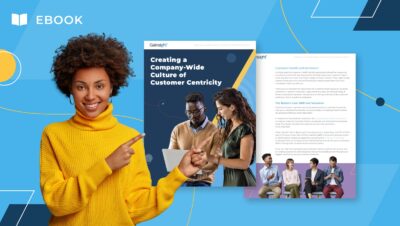Technology can be a force multiplier when it comes to helping people and businesses perform at higher levels. However, whether you’re adding capabilities or eliminating extra steps in a process, technology always brings about some sort of change. A big reason for this is the application of technology usually brings about changes to business processes. Any change to business processes, especially when a human is in the loop, creates a need for training, enablement and ongoing engagement to optimize the human and business value of the technology.
Salesforce’s Courtney Guerci, Sr Program Manager – Technical Support Strategy & Operations, recently joined Gainsight’s Tim Van Lew for a “Titans Of Scale” webinar. In the discussion, she outlined the change management process she and her team followed in order to empower hundreds of their Technical Account Managers (TAMs) around the globe to improve customer success outcomes with Gainsight.
Create a Problem Statement That Defines What You’re Trying to Solve
Effective change management should not include the phrase “Because I Said So”. Long before a platform was selected, Salesforce took steps to clearly define the problem they needed to solve for their TAMs.
Previously, their TAM organization operated out of several systems. This required users to swivel between systems and led to complaints about inconsistent information between systems. Leadership also observed the system fatigue that resulted from employees having to administer processes among all of the tools. With those chief complaints identified and acknowledged, the new CS platform could be introduced as the tool chosen to acutely solve the problems.
Salesforce’s team knew that in order to make the implementation of their chosen customer success platform (CSP) successful, they needed to address the impact on the end user. The project sponsors conducted research to understand implications the platform would have on how their TAM end-users do their job. Leadership was sensitive to the tactical and emotional impact of the change.
Set up Teams and Work Streams to Bring in the Right Perspective
Since members at all levels of the organization had input into defining the problem, it was much easier to get people working collaboratively to implement the solution that would alleviate the identified issues.
Like most enterprise technology implementations, Salesforce set up an Executive Leadership Board that met regularly to status and address risks and blockers. It also had a Technical Implementation Team that focused on deploying the technical plan for the system. But, in order to improve the transparency and effective governance of the project, leadership also established an advisory committee, which proved to be a game-changing decision for the project.
Salesforce’s Gainsight Advisory Committee included individual contributors and manager level team members from multiple geographies and roles in the organization. This cross-functional group met regularly to weigh in on critical project topics, including:
- Business process changes
- Issue management
- Enablement needs
Focus on these topics enabled key stakeholders from all areas to be together at the source of the information exchange. Through these interactions, committee members could see first-hand the need to make adjustments, and participated in decisions to set the system up a certain way.
Turn Naysayers Into Power Users Through Enablement
As the project progressed, Salesforce expanded the initiative’s structure to include a UAT team, post-implementation teams, and a power user group. Assembling these groups even became strategic to ensure representation across teams and time zones.
One group would go through implementation, and then have a two-week timeframe of enablement. Then another team would kick off. Through the phased implementation, power users were identified who then helped with developing the communication plan for other phases of the rollout. Several channels of communication were set up including a dedicated Slack channel that acted as a knowledge repository. Other resources in the communication plan were enablement sessions for training, and then office hours hosted by power users to support peer-to-peer learning.
These approaches resulted in a grassroots effort that helped perpetuate adoption of the system among users, which also helped mitigate resistance to change.
Change Management Isn’t a One-Time Project
Even though a new technology is fully implemented, that does not mean the change management effort stops. For Salesforce, Gainsight is still a topic that comes up at the TAM’s all hands meetings. The group is always revisiting the system, statusing and targeting improvements that will flex the technology to ongoing changes in Salesforce’s business and customer strategies.
The ongoing success of any change management project requires a similar mindset that makes the initial implementation effective. With ongoing leadership backing, and empowered users who have input into things from the beginning, your customer success initiatives will help transform your organization to deliver on the promise of increased retention and revenue expansion.
Learn more about how to create a company-wide culture of customer centricity in our ebook, Creating a Company-Wide Culture of Customer Centricity.

